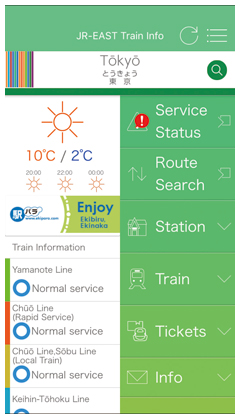 |
|||||||||||||||||||||||
|
|
|||||||||||||||||||||||
|
Feature Articles: NTT Group Activities in the Transportation Field Vol. 14, No. 7, pp. 37–40, July 2016. https://doi.org/10.53829/ntr201607fa7 Agile Development of JR East App Designed to Enhance Customer Service QualityAbstractEast Japan Railway Company (JR East) is a leader in the country’s railway industry and provides passenger railway services in the Kanto, Koshinetsu, and Tohoku regions. It is also engaged in a wide variety of related business activities. In March 2014, as part of the initiative to utilize information and communication technology included in its New Management Vision formulated in 2012, JR East released JR East App, its official smartphone application. This article gives an overview of that application and describes the agile development adopted by NTT Software in creating it. Keywords: smartphone application, agile development, transportation operation status 1. IntroductionEast Japan Railway Company (JR East) simultaneously released Android*1 and iOS*2 versions of JR East App in March 2014. This was its first official application, although the company had earlier released a few experimental or short-term applications. The official app was downloaded 400,000 times in the first month after its release, 1 million times in the first year, and 1.6 million times by February 2016. The application received the Good Design Award in 2014 and the Minister of Internal Affairs and Communications Award in the MCPC (Mobile Computing Promotion Consortium) Awards in 2015. It is still evolving. The current version of the JR East App provides information about the operational status of all lines run by the company, timetables, the current locations of trains, temperatures inside train cars, and the congestion status of trains on selected lines. In addition, it offers information on the floor plans of stations, coin-operated lockers, and other station facilities. It also offers convenient features such as displaying train delay certificates. We have put in place a database and an application programming interface (API) through which the database can be accessed to retrieve information so that the application will be able to serve as a platform for utilizing information from both within and outside of JR East.
2. ICT Information Transmission Project launched as part of New Management VisionIn 1987, the then Japan National Railways was privatized and geographically divided into six regional railway companies, of which JR East is one. It operates a railway network extending 7400 km and comprising 69 lines across a large area that encompasses the Kanto, Koshinetsu, and Tohoku regions. Every day, some 17 million people use JR East trains. In addition to its core business of passenger railway services, JR East is involved in a wide range of related business activities such as operating kiosks and on-train sales. It also owns and operates shopping and office complexes. Today, these facilities constitute an important social infrastructure that is a vital part of Japan’s economic activity. In 2012, the company formulated the JR East Group Management Vision V—Ever Onward, the fifth management vision since the foundation of the company. The vision defines the company’s future management direction, taking into consideration major environmental changes such as the Great East Japan Earthquake. It consists of two priority initiatives: its eternal mission, which involves pursuing extreme safety levels, reforming service quality, and strengthening collaboration with local communities, and its pursuit of limitless potential such as achieving technological innovation, tackling new business areas, developing employees, and creating a corporate culture that maximizes human potential. As part of this vision, JR East decided to study anew the utilization of information and communication technology (ICT) to enhance customer service quality. Specifically, a project was initiated for the purpose of studying how to provide information to customers more effectively. In the course of this project, it was decided to further improve the experimental service called Train Net, which had been introduced a few years earlier by the Research & Development Center of the JR East Group, and to convert it into an official, commercialized application. The ICT Information Transmission Project was launched in order to develop the application. 3. Agile development adopted by NTT SoftwareIn the initial stage of development of JR East App, there was a great deal of enthusiasm among those taking part in developing JR East’s first full-fledged application. A lot of individuals from all relevant departments within JR East, relevant subsidiary companies, and vendors participated in project meetings. Believing that the application would serve as the face of the company, they gave priority to studying the design of the application, that is, the user interface. This meant that technical studies on the system configuration, functionality, and performance were placed on the back burner. To remedy this situation, NTT Software was invited to participate in the project for the purpose of addressing the system development aspect. The aim is to provide information that is well suited to the particular context of the customer by gathering the necessary content from both within and outside of the JR East Group. In particular, JR East focused on creating a sense of information sharing and a sense of an image gap. Creating a sense of information sharing among customers refers to providing information about stations and about the operational status of trains. Creating a sense of an image gap refers to being able to provide content that does not, on the face of it, seem to fit with the conventional, staid image of a railway company. For example, we would make an innovative attempt to provide information about the congestion status of trains, or provide entertaining content such as cartoons that could be enjoyed during brief idle times on a train. Another objective for this application was to establish an information platform that would be useful not only from a service perspective but also from business and operational perspectives. Therefore, vendors that had developed individual existing systems that provide information about train operational status, or information about internal conditions of cars, were invited to participate in developing the application. Unlike the conventional railway software systems that they had been building for many years, smartphone applications and the information that they process are updated frequently. Therefore, it was necessary to break away from the conventional system development approach, starting with defining the requirements. To enable early release of the application, NTT Software adopted an agile development method in which project members were divided into two teams. The day after decisions were made and the general directions of proposed solutions were determined in meetings, the solutions were implemented. Templates were created for the content management system using Grails [1]. Automatic builds in Jenkins [2] were adopted in order to boost development speed and efficiency. Formerly, JR East had tended to custom-build its systems. In contrast, the development of JR East App incorporated existing proven platforms and convenient tools. As a result, the application was developed in only six months, which is half the time required for conventional development projects. The development cost was also cut dramatically. We believe that the cordial relationships among the development project members, based on trust that was nurtured through intensive exchanges of opinions and discussions in weekly meetings, have been major factors in making this project a success. Because the development organization was well thought out, discussions in meetings were not carried over to the next meeting, and specific policies were determined in each meeting. We used three project management tools (Redmine [3], Subversion [4], and Git [5]) which had been introduced to NTT Software. They enabled visualization of the project status and progress and were useful for managing the work by multiple vendors. 4. Proposals implemented to facilitate project managementThe Yamanote Line Train Net capability provided by the application visually presents information about the congestion status and internal temperature of each car in each train. Sensors installed in each car send data every 20–30 seconds, so the total volume of data that needs to be stored and processed is huge. Studying how to store, manage, and use such data to develop new services or enhance service quality was a major issue. This would not have been possible without having put a firm development platform in place. There were some customer-related issues in addition to the system-related issues mentioned above. To address these issues, NTT Software proposed building a data warehouse infrastructure and using a business intelligence tool called Yellowfin [6]. These were adopted and have been helpful in managing the project. 5. Expectations for use toward 2020Two years have passed since JR East first released this application. During that period, the program has been updated monthly to reflect the demands of customers and users. The capabilities of the application have been steadily expanded. My Line Setting, which enables users to quickly check the operational status of trains, has been extended to cover the 51 lines of the 15 private railways in the Tokyo metropolitan area. Train Location Information was also extended to cover a total of 17 lines (by March 2016). We are also working to provide more customer-friendly services that collaborate with other applications, for example, providing information about other transport systems available at each station (e.g., buses and taxis), and linking information with digital signage units inside train stations. The English-version application called JR-EAST Train Info (Fig. 1) [7] has been upgraded to provide information about train locations. An Apple Watch*3 version has also been released. As we approach 2020, JR East App will continue to evolve to become an even more useful tool for more users. The data it will access will continue to grow. We will continue to maintain the current development organization in order to be able to better respond to customer requests in a timely manner.
References
|
|||||||||||||||||||||||










